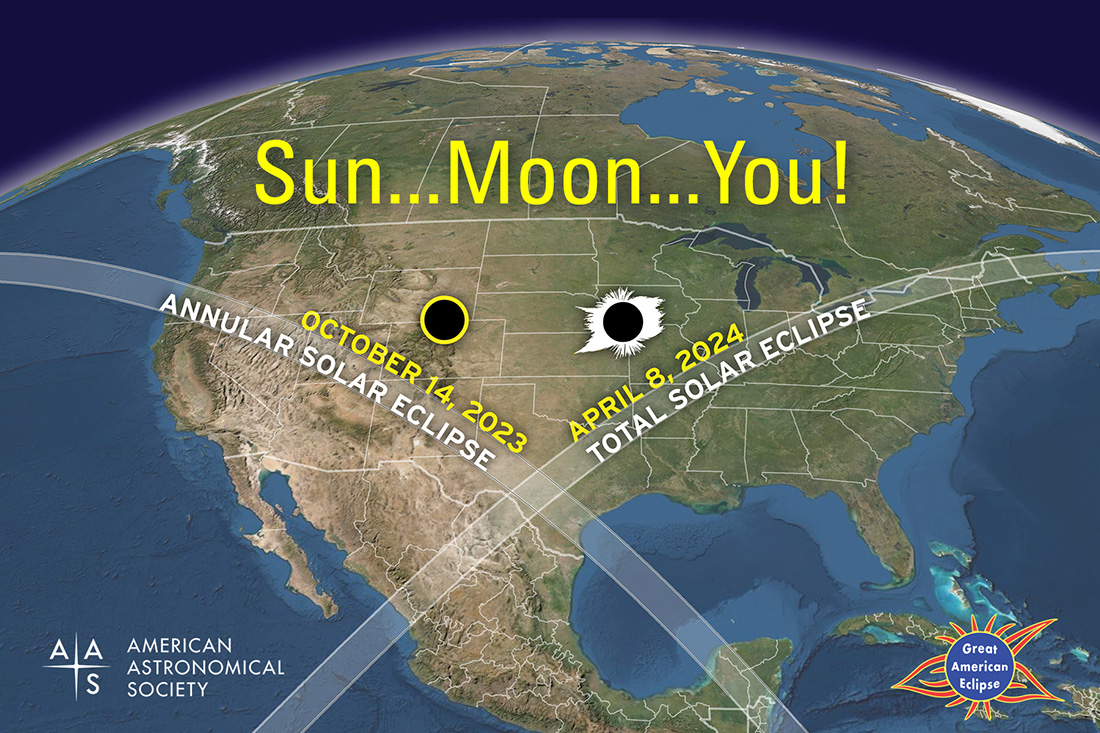When Is the Solar Eclipes Again
Eclipse America 2023-2024
Eclipse America 2023-2024

Dorsum-to-Back American Solar Eclipses!
Practise you recall the total solar eclipse that crossed the continental United states of america from coast to coast on August 21, 2017? If you lot lived in, or traveled into, the 70-mile-wide path of totality, where the Moon completely blocked the Sun and turned twenty-four hour period into night for a few minutes, you lot undoubtedly remember it well. If you were exterior that path under articulate skies somewhere else in Northward America (or northern S America), perhaps you saw a partial solar eclipse that mean solar day.
The 2017 full solar eclipse was the first to bear on the "Lower 48" since 1979 and the first to span the U.South. from coast to coast since 1918. Remarkably, some other total solar eclipse is coming to North America on Apr 8, 2024, just 7 years later the last one. This time the Moon's night key shadow, about 115 miles wide, will cross United mexican states, sweep northeast from Texas to Maine, and then darken the Canadian maritimes. A partial solar eclipse will over again be visible to nearly everyone in North America fortunate to have cloud-free skies.
Even more remarkably, we'll take a dissimilar type of solar eclipse in Northward America simply half-dozen months earlier. On October 14, 2023, the Moon will over again laissez passer directly betwixt Earth and the Sun — simply this time it will not quite completely encompass the solar disk, instead turning information technology into a thin "ring of burn down." This annular (Latin for ring-shaped) eclipse will be visible within a roughly 125-mile-broad path from Oregon to Texas and on into United mexican states. And again, North Americans outside the path will be treated to a partial solar eclipse if the weather cooperates.

Safety First
The only time it is safe to view the Sunday without special-purpose eye protection is during the total stage of a full eclipse, when the Moon completely blocks the Sun'southward bright confront, the sky darkens to deep twilight blue, and the Sun'due south corona — its faint, wispy outer atmosphere — emerges into view. On April 8, 2024, totality volition terminal at most 4½ minutes and will be visible only within the narrow path swept out by the Moon'due south dark shadow. Even inside that path, though, the Sun will be partially eclipsed for more than an hour before totality and again afterward. During these partial phases, y'all must not look at the Sun without proper protection!
For the eclipse on October fourteen, 2023, at to the lowest degree part of the Sun's vivid confront will remain visible throughout the event, so information technology is absolutely essential at all times to view the Sun through a safe solar filter, that is, one that meets the manual requirements of the ISO 12312-ii international standard. Such filters are widely available and cost at about a few dollars. Looking at the uneclipsed or partially (or annularly) eclipsed Sunday through night sunglasses or any other unapproved filter is a recipe for serious and potentially permanent eye injury. Come across our Eye Safety and Resources pages for details.
The post-obit pages contain basic information about the coming Due north American solar eclipses and nigh solar eclipses more by and large, along with links to more comprehensive information on other trusted websites.
- Annular Solar Eclipse: October 14, 2023
- Total Solar Eclipse: April eight, 2024
- How & Why Eclipses Happen
- How to View a Solar Eclipse Safely
- The Solar Eclipse Experience
- A Solar Eclipse Glossary
- Join Our Email List
Source: https://eclipse.aas.org/eclipse-america-2023-2024
Post a Comment for "When Is the Solar Eclipes Again"